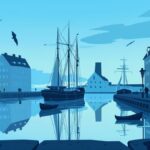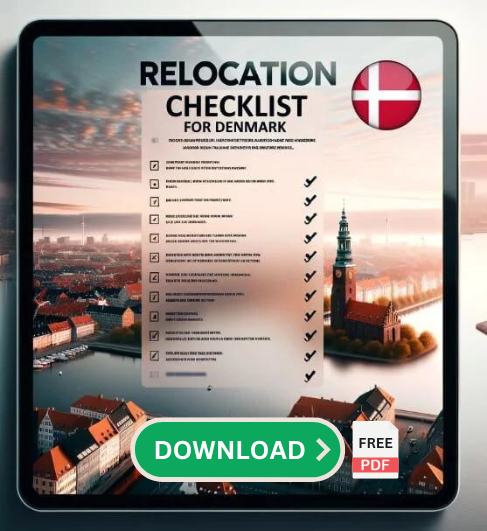Denmark has been a prominent figure in the tapestry of European history. As a key player in the Nordic realm, this nation's narrative is not just about dates and kings; it's about a journey from ancient settlers to a modern-day kingdom. Situated between the North and Baltic Seas, its geography has made it both a cultural crossroads and a strategic prize.
Delve with us to discover when was Denmark founded, understanding the roots and evolution of a nation that stands as a testament to resilience, innovation, and the indomitable spirit of its people.
Key Takeaways
- Denmark's history is a rich tapestry that spans from the early Stone Age inhabitants to the modern era.
- The Viking Era marked Denmark's age of exploration and maritime dominance.
- The Middle Ages in Denmark witnessed the nation's Christianization and the establishment of a strong monarchy.
- During the Renaissance and Early Modern Period, Denmark experienced cultural revival and political transformations.
- The concept of "founding" a nation-state, like Denmark, is a continuum shaped by culture, politics, and shared identity.
When Was Denmark Founded: Stone Age to Bronze Age
Long before the rise of cities and kingdoms, Denmark's landscapes echoed with the footsteps of its earliest inhabitants. These lands, rich in resources and shaped by glaciers, rivers, and seas, became a thriving ground for communities that marked the dawn of Denmark's historical journey.
Stone Age: The Foundation of Settlement
The Stone Age, spanning roughly from 12,000 to 1,800 BCE in Denmark, was characterized by two primary eras: the Paleolithic (Old Stone Age) and the Neolithic (New Stone Age). During the Paleolithic period, the early inhabitants were primarily nomadic hunters and gatherers, navigating a world dominated by vast forests and immense ice sheets. Tools from this era, chiseled meticulously from flint, provide an insight into their survival strategies and ingenuity.
Transitioning into the Neolithic period, a notable shift occurred. As the ice retreated and the climate became more temperate, communities began to settle. They practiced primitive agriculture, cultivating grains like barley and wheat, and domesticated animals.
Megalithic structures, such as dolmens and passage graves, were constructed during this time. These tombs, often adorned with carvings and filled with artifacts, hint at the complex spiritual beliefs and societal hierarchies of these early communities.
Bronze Age: An Era of Cultural Evolution
Following the Stone Age, the Bronze Age, which spanned from around 1,800 to 500 BCE, marked a period of significant cultural and technological advancements in Denmark. Metal, specifically bronze, became the material of choice for crafting tools, weapons, and intricate jewelry. The emergence of this metalwork indicates not just improved crafting skills but also the establishment of trade networks, connecting Denmark to distant lands.
The landscape was dotted with burial mounds, revealing a deep reverence for the dead and possibly the belief in an afterlife. Rituals and ceremonies became more elaborate, as evidenced by the intricate petroglyphs or rock carvings found in various parts of the country. These carvings, depicting scenes of ships, sun symbols, and daily life, provide a visual documentation of the beliefs, aspirations, and daily lives of the people during this era.
The Iron Age: A Time of Transformation
As Denmark journeyed from the Bronze Age, a new epoch dawned, heralding even more profound changes in the socio-cultural and political fabric of the region. The Iron Age, extending from approximately 500 BCE to 800 CE, was not merely a transition in terms of metallurgy; it signified the transformation of Denmark from isolated settlements into a more connected, sophisticated, and evolving society.
Iron: The Metal that Changed Everything
The advent of iron reshaped the dynamics of daily life and warfare. Unlike bronze, which required tin and copper—elements not abundantly found in Scandinavia—iron was sourced more locally, leading to a more self-reliant production process. This newfound access to a robust and versatile material enabled the creation of more effective tools, weapons, and artifacts. This was not just an era of improved tools, but of burgeoning craftsmanship that echoed the skills and aesthetics of the age.
Societal Shifts and the Jelling Stones
The Iron Age also marked pivotal societal and political shifts. Settlements grew in size and complexity, indicative of an increasingly organized societal structure. This period bore witness to the construction of fortresses and ring fortifications, evidencing the need for both protection and demonstration of power.
Amidst these transformative years, the Jelling stones stand out as emblematic monuments of the era. Erected by King Gorm the Old in honor of his wife and later by his son, King Harald Bluetooth, to mark the Christianization of the Danes, these rune stones and burial mounds serve as both a historical record and a testament to the changing religious and cultural identity of Denmark. The inscriptions on these stones encapsulate tales of power, ambition, and a nation in flux.
Trade and External Relations
Another hallmark of the Iron Age was the development of extensive trade networks. Goods from as far away as the Roman Empire found their way to Denmark, highlighting the nation's growing economic influence and its integration into a broader European context. These trade relations, while bolstering the economy, also facilitated cultural exchanges, enriching Denmark's tapestry of traditions, beliefs, and practices.
Viking Era: Denmark's Age of Exploration and Expansion
As the Iron Age began to wane, a new and indomitable spirit was awakening in the heart of Denmark, setting the stage for what is arguably one of the most iconic epochs in its history: the Viking Era. From the late 8th century to the early 11th century, the Norse seafarers, explorers, traders, and warriors emerged, not just as a force to be reckoned with, but as cultural ambassadors, leaving an indelible mark wherever they set foot.
The Sea's Call: Raiders and Explorers
The term 'Viking' often conjures images of fearsome warriors with horned helmets embarking on raids. While raids were a part of the Viking identity, it only paints a partial picture. With their unparalleled shipbuilding skills, the Vikings designed vessels that could navigate both deep seas and shallow rivers with ease. These longships, with their distinct dragon-prowed designs, became symbols of their era, facilitating not just raids, but also exploration, trade, and colonization.
Their maritime prowess led them to uncharted territories, from the icy landscapes of Greenland and the Americas in the west to the sophisticated Byzantine Empire in the east. Each journey, whether driven by trade, exploration, or conquest, intertwined the Viking legacy with the histories of numerous lands and peoples.
King Gorm and the Dawn of a Unified Denmark
Amidst the external voyages, significant political shifts were occurring within Denmark. King Gorm the Old, ruling in the latter part of the 10th century, is often regarded as the first historically recognized king of a unified Denmark. His reign, while significant in its own right, was further illuminated by the achievements of his son, King Harald Bluetooth. Harald's legacy was monumental in uniting the various Danish tribes under a single banner and initiating Denmark's transition to Christianity, thus sewing the seeds for the formation of a cohesive Danish identity.
A Tapestry of Culture and Commerce
While often celebrated for their martial abilities, the Vikings were equally skilled in commerce and craftsmanship. Trade routes were established, connecting Denmark with distant markets from the Arabian Peninsula to the British Isles. This extensive trade enriched the Danish economy and brought a plethora of foreign goods, ideas, and artistic influences, leading to a vibrant fusion of cultures.
Silver hoards, ornate jewelry, intricate runestones, and sagas penned during this era provide a window into the Viking world, showcasing their artistry, beliefs, values, and their deeply rooted sense of honor and kinship.

Middle Ages: Christianity and The Formation of the Danish Monarchy
Following the vibrant and tumultuous Viking Era, Denmark transitioned into the Middle Ages, a period spanning roughly from the 11th to the 16th century. This era was marked by profound socio-political transformations, religious fervor, and the crystallization of the Danish monarchy. As the Viking ships retreated from the limelight, cathedrals, castles, and royal decrees began to shape the nation's evolving narrative.
The Christianization of Denmark
The seeds of Christianity, sown during the final years of the Viking Era, began to take root and flourish in the Danish soil during the Middle Ages. The efforts of King Harald Bluetooth in the 10th century had set the stage, but it was in the subsequent centuries that the religion truly became entrenched.
Missionaries, both local and from neighboring regions, played a crucial role in spreading the Christian faith. Monasteries and churches sprouted across the Danish landscape, becoming centers of learning, culture, and spiritual guidance. The architecture of the period, characterized by Romanesque and Gothic styles, bore testimony to the nation's newfound religious zeal. The towering spires of cathedrals, such as the ones in Roskilde and Lund, reached skywards, symbolizing the aspiration of the Danes towards divine communion.
Establishment of the Danish Monarchy
Parallel to the spiritual awakening was the firm establishment and consolidation of the Danish monarchy. The early Middle Ages saw the reigns of influential kings like Canute the Great, who not only ruled Denmark but extended his dominion to England and parts of Norway, showcasing the continued ambition of the Danish crown.
The medieval Danish monarchy was also characterized by the formulation of the Law of Jutland, a significant legal document that codified the rights and duties of the kingdom's subjects. This was a testament to the evolving administrative machinery and the attempts to bring a semblance of order and justice to the realm.
Dynastic struggles, alliances, and conflicts with neighboring regions, especially the Hanseatic League and the other Nordic kingdoms, added layers of complexity to the political tapestry. Castles, like the ones at Helsingør and Kolding, served dual purposes – as formidable fortresses guarding against external threats and as majestic residences reflecting the grandeur of the monarchy.
Cultural Flourishing and Challenges
The Middle Ages were not merely about politics and religion. It was an era where Danish culture, art, and literature began to flourish. Manuscripts were illuminated, sagas were penned, and ballads echoed tales of heroism, love, and tragedy.
However, this period was not without its challenges. Plagues, especially the Black Death in the 14th century, swept through Denmark, decimating its population and leaving a profound impact on society. The scars of these challenges, however, only fortified the nation's resolve and resilience.
Renaissance to Early Modern Period: A Flourishing Nation
The transition from the Middle Ages to the Renaissance and Early Modern period heralded a reawakening of art, science, and intellect, mirrored in the tapestries of Denmark's cultural and political landscapes. Spanning from the late 16th to the 18th century, these years witnessed Denmark embracing new paradigms, innovating in various realms, and further solidifying its place in the European tableau.
| Aspect | Key Highlights |
| Arts | Shift to Renaissance designs; notable architecture like Rosenborg Castle. |
| Sciences | Contributions by astronomers like Tycho Brahe. |
| Literature | Flourishing of writers and poets, facilitated by the printing press. |
| Politics | Advent of absolutism and the Kongeloven (King's Law) of 1665. |
| Global Outreach | Establishment of the Danish East India Company; colonial endeavors in India, Caribbean, and Africa. |
The Renaissance: Rebirth of Arts and Sciences
Denmark, like much of Europe, was influenced by the Renaissance's wind – a cultural movement that prized the rediscovery of classical Greco-Roman knowledge and celebrated humanistic values. The period saw a surge in artistic, scientific, and literary endeavors.
Arts: Danish architecture underwent a transformation, moving away from the Gothic styles of the Middle Ages to more symmetrical, ornate Renaissance designs. Structures like Rosenborg Castle in Copenhagen epitomized this architectural renaissance. Furthermore, artists and sculptors brought to life portraits, landscapes, and sculptures that captured the zeitgeist of the age.
Sciences: The era also brought about advancements in the realm of science. The famed Danish astronomer Tycho Brahe made significant contributions to observational astronomy, laying foundational knowledge for future generations.
Literature: Literary pursuits flourished, with writers and poets infusing their works with both classical inspiration and contemporary reflections. The printing press's advent played a crucial role in disseminating knowledge and ideas, making literature and scholarly works more accessible to the masses.
The Rise of Absolutism
Politically, the 17th century marked a significant shift in the balance of power with the advent of absolutism. The Treaty of Roskilde in 1658, though it resulted in territorial losses to Sweden, set the stage for King Frederick III's declaration of hereditary monarchy and the subsequent establishment of absolute rule.
This centralization of power under the monarch was codified in the Kongeloven (King's Law) of 1665, which declared the king as the supreme authority, answerable only to God. Such a shift had profound implications for governance, administration, and the relationship between the monarchy and its subjects.
Trade, Colonial Ambitions, and Global Outreach
The Early Modern Period saw Denmark venturing beyond European shores, echoing its Viking ancestors' explorative spirit. The establishment of the Danish East India Company in the 17th century marked Denmark's foray into global trade networks, leading to colonial endeavors in the Indian subcontinent, the Caribbean, and Africa.
Greenland, Faroe Islands, and Iceland, though closer to home, became more integral to the Danish kingdom during this period. These territories not only offered strategic advantages but also enriched Denmark with their unique cultures and resources.
Enlightenment and Societal Progress
As the 18th century dawned, the winds of the Enlightenment breezed through Denmark. Philosophers and scholars championed reason, science, and individual rights. Reforms were initiated in sectors like education, agriculture, and administration. The seeds of democratic thought and societal progress, planted during this period, would eventually bear fruit in the subsequent centuries.
Defining "Founding": The Concept of a Nation-State
Delving deep into the annals of history often begs the question: When can we truly say a nation was "founded"? As we traverse through Denmark's rich tapestry of events, from the early inhabitants to the early modern era, it becomes evident that the concept of "founding" is more nuanced than a mere date or a single event. The emergence of a nation-state, especially one as historically rich as Denmark, is a gradual confluence of culture, politics, society, and shared identity.
The Evolutionary Perspective
To truly grasp the "founding" of Denmark, it's imperative to adopt an evolutionary perspective. Every era, every pivotal moment, whether it's the construction of megalithic tombs during the Stone Age, the maritime explorations of the Vikings, or the political consolidations of the Middle Ages, contributed a piece to the intricate puzzle that is Denmark.
A nation-state is not just a political entity but a cultural and social construct. The shared myths, tales, songs, and traditions that echoed through the halls of Viking longhouses, the spires of Gothic cathedrals, or the courts of Renaissance palaces all wove the fabric of a collective Danish identity. The stories of legendary figures, the celebration of festivals, and even the shared struggles against external forces all played roles in creating a sense of unity and belonging.
Political and Territorial Consolidation
While shared culture is a cornerstone, the political and territorial consolidations also hold undeniable significance. The reigns of influential kings, the establishment of laws, and the demarcation of boundaries, all contribute to the delineation of a nation-state. In Denmark's context, moments like the unification efforts of King Harald Bluetooth or the advent of absolutism under King Frederick III marked milestones in the journey towards a centralized, sovereign entity.
International Recognition and Diplomacy
The interactions with neighboring regions and far-off lands, be it through trade, war, or diplomacy, also factor into the "founding" equation. As Denmark engaged in treaties, trade pacts, and even conflicts, it not only asserted its sovereignty but also gained recognition on the international stage. This external acknowledgment is pivotal in the evolution of a nation-state.
In Reflection
To pinpoint a singular "founding" moment for Denmark, or any nation-state for that matter, is to oversimplify the myriad of forces, events, and evolutions that shape its existence. Instead, it's perhaps more accurate to perceive the "founding" as a continuum—a series of interconnected moments, decisions, and evolutions that collectively birth a nation. In the case of Denmark, it's a tale that spans millennia, a testament to its enduring spirit and rich heritage.






